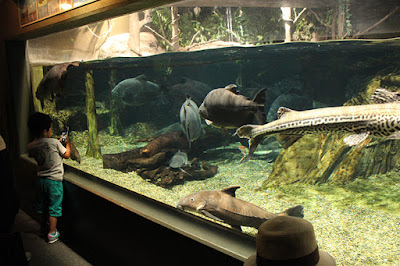The
official name of this facility is “World Freshwater Aquarium Aquatotto Gifu”,
and true to its name, it showcases freshwater fishes from Japan, Southeast
Asia, Africa, and South America.
According to a friend who is originally from the Gifu area, the word “totto”
is a children’s word for “fish” in the local dialect. Opened in 2004, Aquatotto Gifu still has the clean
look of a new aquarium, and its exhibits incorporate many interesting modern
design elements.
Upon
entering the facility, visitors are instructed to ride an elevator to the 4th
floor. This upper floor is designed to
represent the mountain areas which are the source and upstream areas of the local
Nagara River which flows through Gifu Prefecture. From here, as visitors walk downstairs in
this building, they will encounter exhibits appropriate to their travelling
downstream along the Nagara River.
Source and Upstream
area of the Nagara River
Artificial trees suggest a
mountain forest.
This exhibit
depicts a mountain stream filled with Japanese char.
The
photo below shows a feeding demonstration with Oriental short-clawed
otters. Ironically, these otters are
native to Southeast Asia - Japan’s species of otters have already gone extinct. I suspect these animals were included in this
“Japanese river” area mostly as a marketing decision. Whether at a zoo or an aquarium, Japanese visitors
go nuts for cute and furry animals.
Aquarium gift shops are almost certain to have plush toy critters, and
plush toy otters are particularly popular.
Ramp
walkway leading from the 4th floor to the 3rd floor.
Exhibit
depicting mountain stream stocked with Japanese “Oikawa”.
Another
view of an Oriental short-clawed otter.
Complete
with cascading water, these exhibits look and feel like a real stream.
Upper Nagara River to
Middle Nagara River
This
section skillfully depicted the changing environment of the Nagara River as it
flowed through the areas populated by humans.
The below 2 photographs show mice that inhabit the rice fields
cultivated along the Nagara River.
Small
exhibit tanks showcased small fish, reptiles, and insects found along the banks
of the Nagara River.
Exhibits
like the one depicted below successfully recreated the small environments and
their small residents.
A
larger tank was populated by catfish and carp.
Middle Nagara River to the
River Mouth
This section showed the river
environments of the middle river, lower river, and river mouth. Most of the tanks were small, and most of the
displayed specimens were also small. In
the larger tanks depicting the river mouth, there were not only freshwater
fish, but also fish like sea bream and Japanese sea perch that live in that
zone where fresh and salt water mix.
Naked
threespine stickleback
Shuttles
hoppfish
This
exhibit showed fish that inhabit the Kushiro Marsh in Hokkaido.
Japanese
huchen
Mekong River Area
This
area featured fish from the Mekong River in Southeast Asia. The tanks in this area were larger, and some
of the fish were notably large.
Bighead carp
Many
colorful fish
Spotted
archerfish
Giant
river prawn
Congo River
This area featured fish from
the Congo River in Africa. Like the
Mekong area, this area was notable for its large tanks and large fish.
Jewel
fish
Nile
perch
Amazon River
Like
the Amazon River for which this area was named, there was a lot of water in
this area. The tanks were quite
large. And the fish were also quite
large. It almost seems like Japanese
aquariums use these large fish from Southeast Asia, Africa, and South America
to make up for the fact that there are few large fish found in Japanese rivers
and lakes.
Red-tail
catfish
Red
piranha
Area very
nicely decorated with soft lighting.
Educational Efforts
There were many educational
signs and displays. Unfortunately, there
wasn’t much English.
The “Toto
Lab”, a reading room for visitors. I did
not have time to examine what types of books they had on their shelves.
Opportunities for
Animal Encounters
According to a sign posted in
this area, on Saturdays, Sundays, and Holidays, visitors can feed the Aldabra
Tortoises for 200 yen.
Just
before the exit, there was an area where visitors could feed fish for 100 yen.
In
this same area, there were 3 Capybara.
Capybara are very popular in Japanese zoos and aquariums because they
are cute, docile, and relatively tolerant of humans.
At
specified times, visitors could feed the Capybara for 100 yen. This activity was limited to 30 visitors on a
first-come, first-served basis.
Food and Souvenirs
The Aquatotto Gifu facility
included a restaurant called “Arrowana Garden”.
A
variety of dishes were available.
There
were also many food trucks parked in the walkways immediately outside of the
Aquatotto building.
The
gift shop was fully stocked with plush toys, pens, accessories, toys, and many
other trinkets. And of course there were
plush toy otters.
Getting There
Aquatotto
Gifu is located in a relatively rural area, and it is not that easy to access
without a car. On this occasion, a friend drove a group of us to Aquatotto Gifu
from Inuyama, so I am not able to describe how difficult it is to access the facility
using only public transportation.
According to the facility pamphlet, visitors can catch a bus from Gifu
train station and get off at the Kawashima-Kasada bus stop. From there, it is reportedly a 15 minute
walk. (In my experience, Japanese estimates for walking times are notoriously
overly optimistic.) Please refer to the
Aquatotto web site for details.
(Note:
The photos used in this post were taken during a visit on July 9, 2017. The comments in this post are based on
observations made on that day.
Conditions may have since changed.
Please check it out for yourself!)









































































































